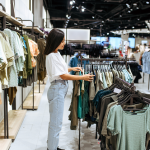Consumers are saving more and spending less, according to our research. But savvy retailers can keep current customers happy by using data and AI to create excellent customer experiences.
It’s the most wonderful time of the retail year: Companies are gearing up for another competitive peak-shopping season. While the 2022 season focused on increasing profitability during a challenging economy, Salesforce’s holiday shopping predictions show that 2023 is all about keeping loyal customers happy.
Why? Because finding new customers is getting more expensive — and marketing budgets are shrinking. Since existing customers drive most of the retailers’ revenue, keeping them satisfied this season should be the top priority. We expect retailers will do so by using AI and customer data to improve operational efficiency and increase wallet share.
Turn holiday shopping trends into yearlong retail success
Learn how 1.5+ billion consumers are shaping retail, from holiday sprees to everyday needs.



Keeping customers satisfied has been a tall order over the last few years. In 2020, safety and fast delivery kept them coming back. In 2021, they favored retailers who had the products they needed in stock. Last year, they switched brands for lower prices, and this year consumer preferences continue to evolve.
While approximately half of consumers worldwide feel pessimistic about the economy, they feel better about their own finances: Two-thirds say their financial situation has either remained the same or improved. That’s because they’re saving more and buying less. More than a third (37%) are making fewer purchases than they were six months ago, compared to 18% who are buying more.
With consumers buying less, retailers must give them a reason to shop from their brand. Pricing and value are still important — 82% of shoppers search for voucher codes before making a purchase – but personalised experiences are critical as well. In fact, 66% of people expect companies to understand (and meet) their unique needs and expectations.
The good news: Customer loyalty is on the rise. According to Q1 Shopping Index data, the share of orders from repeat buyers grew 5% year over year. In fact, we expect more than one in three online peak-season orders will come from repeat buyers this shopping season.
Here are our five peak-season shopping predictions for 2023:
Generative and predictive AI will influence digital sales
The buzz around GPT and other generative AI models is dominating headlines this year, and the tools are going mainstream. According to our research, 17% of consumers have used GPT for product research and inspiration, and 10% will likely use it to help build their festive shopping lists.
Predictive AI has already played a critical role in the online shopping experience. AI-generated product recommendations have been used by e-commerce merchants and digital marketers for years, offering consumers suggestions on the product detail page, in the shopping cart, and beyond. But with the rise of generative AI – which uses human prompts, algorithms, and data to create new and original content like text, images, and music – we expect retailers to further personalise the shopping experience.
Brands and retailers will embrace this technology over the peak season, using customer data to create better, more personalised shopping experiences that add value and increase loyalty. The greatest impacts will be in:
Marketing: Automating marketing campaigns and drafting content for emails, landing pages, text messages, social media, and apps.
Commerce: Offering conversational site search for a more human and natural way to find the perfect gift across digital touchpoints.
Service: Creating more nuanced – and human – chatbot responses that can deeply understand, anticipate, and respond to questions.
Our prediction: As consumers continue to engage with marketing, buying, and service experiences generated by AI, the technology will influence £151 billion in global online peak-season shopping spend.
Poor returns experiences will cost sales
Efficiently managing returns and reducing their frequency has become a top priority for retailers. During last year’s peak shopping season, there was a significant 12% increase in returns. As a result, brands and retailers looked to rein in historically liberal policies to stem the flood of returned merchandise.
But so far, their efforts have largely focused on restrictions rather than creating an experience that balances customer satisfaction with operational efficiency. This decreased returns only by 1% in the first quarter of 2023.
Our research shows that the returns experience significantly affects buying decisions and, if not executed properly, could cause loyal shoppers to abandon retailers and brands. Returns must be:
Clear: 93% of shoppers research a brand or retailer’s return policy before making a purchase.
Easy: 81% of shoppers have stopped buying from a brand or retailer after one bad return experience.
Reasonable: 78% of shoppers have abandoned a shopping cart if free returns weren’t available. And 30% said getting a refund instead of store credit influenced where and when they purchased.
In our uncertain economy, shoppers will continue to be more deliberate. That may mean even more returns, and the potential to retain or lose loyal customers.
Our prediction: Poor returns experiences – from policies and processes – will put 21% of online orders at risk.
Click & Collect will drive incremental store purchases
Click & Collect (C&C) options gained popularity in 2020 and have remained essential for shoppers. Our research shows C&C influences people to consider a particular retailer, with 39% of shoppers seeking out retailers who offer it.
It can help sales, too, since 41% of shoppers are more likely than a year ago to buy after they browse online for inventory available in physical locations. This omnichannel buying behaviour shows that visibility and convenience are loyalty drivers.
During the 2022 holiday shopping season, one in five online orders were fulfilled via C&C, surging to over one in three after the shipping cutoff dates.
But C&C is complex to execute. Stores must implement new training, processes, metrics, and incentives to scale it profitably. And tools that allow seamless execution are critical to balance streamlined execution, high customer satisfaction, and positive associate morale.
Our research also shows that C&C generates value for the brand and retailer: Companies that offer C&C grew their online revenue seven times faster than brick-and-mortar stores that didn’t offer the option. But this year, we believe the value of C&C won’t be limited to increases in online sales.
Our prediction: BOPIS will drive £22 billion in incremental global store sales when customers pick up their online orders.
Social media ads will deliver the best ROI
Social media’s role in the shopper journey is growing. In the first quarter of 2023, traffic referrals from social media platforms grew 27% year over year — even as the shopping journey became more complex and fragmented across an average of nine channels. But our research shows social media’s influence reaching beyond the digital landscape to in-store behaviour. In the past three months, more than half of consumers said they went to a physical store to see or buy products they discovered on their social feeds.
How are shoppers engaging with products on social media? For many years, influencer marketing drove the bulk of social engagement, but recent studies suggest its impact is waning. Our research shows shoppers are nearly twice as likely to buy a product if it was advertised in their social feeds than if they saw an influencer promote it.
Social media advertising may also be more effective than traditional marketing tactics. For example, 50% of shoppers are more likely to visit a brand or retailer’s website after seeing a social media ad, compared to 39% of shoppers who receive a promotional email. Brands and retailers must embed themselves in their existing customers’ preferred channels to generate inspiration at the right moment.
Our prediction: Social media advertising will drive 10 times more online peak shopping visits than traditional marketing.
Consumers will embrace the resale market to save money – and the planet
The resale market has been a fan favourite since the dawn of the internet age. Anyone with an eBay account could buy and sell used goods in the U.K. and now across the globe, paving the way for today’s online marketplaces like Facebook Marketplace, ASOS and Amazon.
Now brands and retailers are reselling their used merchandise from existing customers. Once a customer trades in a product, they’re encouraged to buy a new item – creating stickiness with the brand. For example, Coach’s website includes a category for “recycled” bags, products previously owned that were deconstructed and redesigned into one-of-a-kind items. This new and creative offering gives loyal customers a reason to return to the site, which may lead to additional purchases.
Why are consumers gravitating towards resold goods? They want to save money, be more sustainable, and get products faster than some new products’ delivery times allow. Over one in three consumers say they’ll buy a used item for someone else in the next six months.
Our prediction: 17% of gifts this peak season will be a resold item, saving 32 billion pounds of additional waste in landfills.
What our holiday shopping predictions mean for you
Customer retention comes down to knowing your customers. Understanding their needs, preferences, profile, and history is the first step in building a successful peak-season strategy. Begin with what you have – your customer data – and use tools like AI and automation to meet your customers at the right moment. That’s how you create customer experiences that keep shoppers loyal at peak shopping moments and throughout the retail year.
Delight your loyal customers this holiday season
Learn to use data and AI to create magical retail experiences.



























